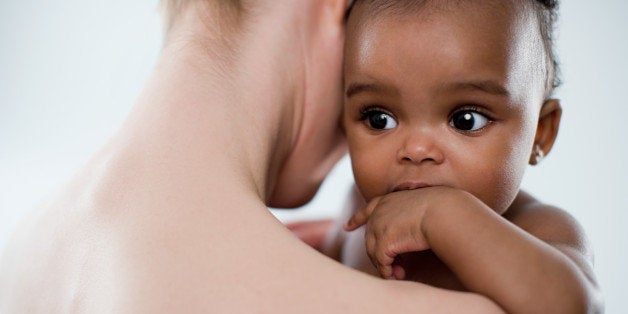
Maybe I missed it in earlier issues of the country's largest and oldest magazine on adoption, Adoptive Families, but the ads in the latest issue, Winter 2014, show the definitive commodification of adoption in the U.S.. Similac pays for a full-page ad in an issue with an article on breastfeeding without birthing and offers its specific product, "Similac for Supplementation." Then there are two full-page ads for businesses that deal with embryo adoption: "Embryos available now to start your family," exclaims AER. And the company with the smart name, "Building Blocks to Baby Steps," uses its page to take a swipe at the usual providers of babies, the presumed unhealthy birth mothers: "Embryo adoption is usually quicker and less expensive than traditional adoption with the added bonus of the mom-to-be having control over the pre-natal environment, raising the chances of delivering a healthy baby." And then a bank -- a Christian bank -- offers "Adoption Loans" with rates as low as 8.65 APR. Again, an implicit swipe to the God-forgotten birth moms. It quotes a customer: 'Without this loan, God's plan for our lives and the life of our child would not be possible." Bored already with the quotes? Please wait for this last one, the most expensive, presumably, because it enhances the back cover of the magazine. The ad is from a company called Adoptimist, who promises: "We build effective adoption profiles and marketing campaigns for families hoping to adopt." And they have "marketing plans for every budget." Market yourself to the first mothers and families in competition with other parents to get your baby? What are these people thinking? And what is Adoptive Families thinking?
In the Winter issue there are many more ads: Half and quarter pages from less affluent adoption businesses like agencies and adoption professionals. The magazine allows the following smaller ads: "Children are waiting for you," they say; or they express messages along the lines of 'We deliver right from the hospital, fresh from somebody else's womb in a third world country through surrogacy, from the Philippines, Poland, from Colombia, and so on.' Taken together, they make adoption -- "real body" or embryo adoption with or without a "gestational carrier" (sic) -- look like as just other ways to build a family.
It must be said that the contents of Adoptive Families gives a somewhat less commercial, more realistic image of what adoption is. There are articles on language disabilities in adopted kids, about race and racism in transracial adoptions, some interesting personal stories and there is a book list which contains "real" titles like Cris Beam's To the End of June on our failing foster care system and Kathryn Joyce's investigation in the corrupt world of international adoption. But in the end, the magazine exudes the same message at its ads, and the commodification shows in its contents. In this issue, there is a chart like you can find in car magazines of the costs of adoption and timing involved per country.
There is one small ad that leads away from the adoptive family as a 'normal-family-in-a-normal-commercial-context' narrative. The ad is for Cono Christian School, a boarding school in Iowa. It offers support for children and families "struggling after adoption, divorce, remarriage." Here we get a look into the troubles that can come with adoption: traumatized kids out of control who need to be brought back to "normal" life.
Adoption is not a normal way to build a family. It is a complicated way, which next to happiness for adoptive parents brings sorrow and sadness for all involved. To part from your child in whatever situation you may be in is traumatizing. To be parted from your parents, whoever they may be, is traumatizing. To create a family with a child who is traumatized by her or his adoption is a tough call, because trauma can be contagious, and triggers unresolved trauma in the adoptive parents.
The push for normalcy that Adoptive Families -- or the larger adoption industry, for that matter -- displays does an enormous disservice to the adoption community, to the kids, to the first parents and to the adoptive parents. That normalcy prohibits thinking about adoption in terms of adoption itself and those terms are all about difference. My kids are Black and I am white. I, being gay, have a biological mother, who cared for me from day one. They have a first mother, who they seldom see. I have one set of parents and they have two. They have the traumatic experience of abandonment, which I don't have. They are the exception in almost every crowd, while I am the norm. They are displaced from a foreign world, while I stayed home. They are poor, and I am rich. And so the list goes on. A similar list can be made for the differences between first parents and me, where class difference might be the most prominent.
Normalcy is an unhealthy place for adopted kids. We have to raise our kids in profound understanding and authentic celebration of their difference. Those who want to raise their kids as "normal" kids and try to conform them to their own image just shouldn't adopt. Those who go the path of difference should be trained in an adequate manner before they bring their child home and should get comprehensive support after the adoption. There is nothing "normal" about adoption: For me, that is the greatest gift my kids have given me. I hope I am strong enough to reciprocate.